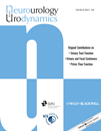Abstract
Aims
To evaluate the relationship between treatment-related changes in Overactive Bladder Symptom Scores (OABSS) and health-related quality of life (HRQOL) questionnaires.
Methods
Ninety-five patients with OAB symptoms were enrolled. All patients completed the OABSS, International Prostate Symptom Score (IPSS)-Quality Of Life (QOL) index and King's Health Questionnaire (KHQ) at enrolment and then again 4, 8, and 12 weeks after treatment with propiverine hydrochloride 10 mg twice daily. We evaluated the relationship between treatment-related changes in the OABSS, IPSS-QOL, and KHQ.
Results
Statistically significant improvements were observed in all 4 OABSS subscales and total OABSS from baseline to 4 weeks with further improvements occurring at 12 weeks (all P < 0.01). The OABSS after antimuscarinic treatment correlated positively with both the IPSS-QOL index and KHQ domain scores. There was a moderate but statistically significant correlation between the change in total OABSS and 2 OABSS subscales (urinary urgency and urge incontinence) and improvement in the IPSS-QOL index (P < 0.01). Treatment-related changes in total OABSS were significantly correlated with changes in six KHQ domains. Moderate but statistically significant correlations were observed between the change in total OABSS and impact on life, physical limitations, emotions, and severity measures (r > 0.30, P < 0.05). Small but statistically significant correlations were observed between the change in total OABSS and role limitations or social limitations (P < 0.05).
Conclusions
Improvement in the OABSS correlated with improvements in HRQOL after treatment. The OABSS is a useful tool to evaluate OAB symptom severity after medical treatment. Neurourol. Urodynam. 30:1309–1314, 2011. © 2011 Wiley-Liss, Inc.




